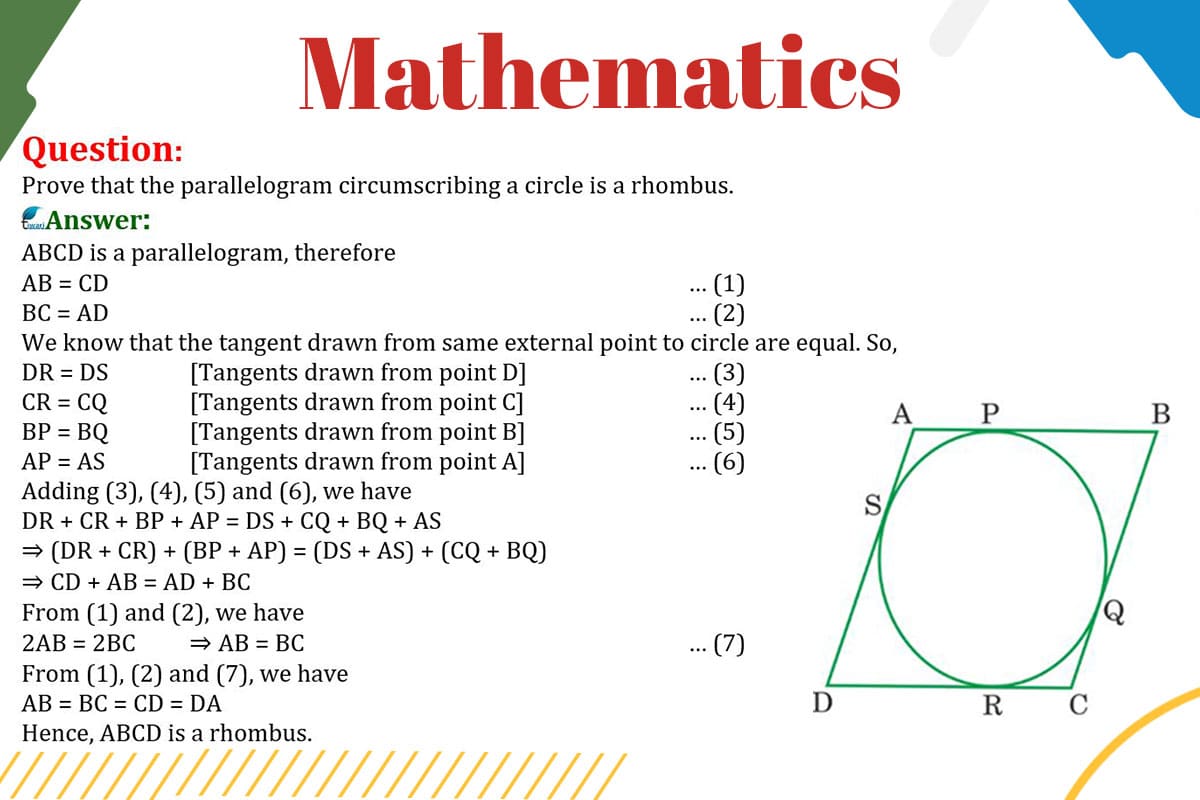To prove that opposite sides of a quadrilateral circumscribing a circle subtend supplementary angles at the center of the circle:
Quadrilateral and Circle: Consider a quadrilateral ABCD circumscribing a circle, with points of tangency E, F, G, and H on sides AB, BC, CD, and DA, respectively.
Equal Tangents: Tangents from a common point to a circle are equal. Therefore, AE = AH, BF = BE, CG = CF, and DH = DG.
Arcs Subtended by Sides: The arc subtended by side AB is equal to the arc subtended by side CD since AE = DH and AH = DE.
Angle at Center: The angle subtended by an arc at the center of the circle is twice the angle subtended at any point on the remaining part of the circle.
Supplementary Angles: Since AB and CD subtend equal arcs, the angles they subtend at the center are equal. Similarly, for BC and DA. Therefore, the angles subtended by opposite sides are supplementary (sum to 180°).
Conclusion: Opposite sides of a quadrilateral circumscribing a circle subtend supplementary angles at the center of the circle.
This proof demonstrates the relationship between tangents, arcs, and angles in a circumscribed quadrilateral, showcasing the harmony of circle geometry.

Let’s discuss in detail
Introduction to Circumscribed Quadrilaterals
In the study of geometry, the properties of shapes circumscribing circles offer intriguing insights. A particularly interesting case is a quadrilateral that circumscribes a circle. A notable property of such a configuration is that the opposite sides of the quadrilateral subtend supplementary angles at the center of the circle. This property is not immediately apparent and requires an understanding of the relationships between the sides of the quadrilateral, the tangents to the circle, and the angles subtended at the circle’s center.
Understanding Tangents in Circumscribed Figures
In a quadrilateral ABCD circumscribing a circle, each side of the quadrilateral acts as a tangent to the circle at specific points. These points of tangency are crucial for our proof. A key property of tangents is that lengths of tangents drawn from the same external point to a circle are equal. This means that in our quadrilateral, the tangents from the vertices to their respective points of tangency are equal in length.
Equal Tangents and Their Implications
Let’s denote the points of tangency on AB, BC, CD, and DA as E, F, G, and H, respectively. By the property of tangents, AE = AH, BF = BE, CG = CF, and DH = DG. This equality of tangents implies that the arcs subtended by the sides of the quadrilateral are related. Specifically, the arc subtended by side AB is equal to the arc subtended by side CD, and similarly for the other pair of opposite sides.
Angles Subtended by Arcs
The angle subtended by an arc at the center of a circle is a measure of the arc’s ‘spread’. In our scenario, since the arcs subtended by AB and CD are equal, the angles they subtend at the center of the circle are also equal. This is a direct consequence of the circle’s properties, where equal arcs subtend equal angles at the center.
Supplementary Angles at the Center
Since AB and CD subtend equal arcs and hence equal angles at the center, the sum of these angles is 180°, making them supplementary. The same logic applies to the other pair of opposite sides, BC and DA. Thus, the angles subtended by each pair of opposite sides at the center of the circle are supplementary.
Supplementary Angles in Circumscribed Quadrilaterals
In conclusion, we have shown that in a quadrilateral circumscribing a circle, the opposite sides subtend supplementary angles at the center of the circle. This property elegantly demonstrates the interplay of tangents, arcs, and angles in circumscribed figures, highlighting the coherence and beauty of geometric principles. It is a testament to the intricate relationships that exist within geometric configurations, particularly those involving circumscribed shapes.
Discuss this question in detail or visit to Class 10 Maths Chapter 10 for all questions.
Questions of 10th Maths Exercise 10.2 in Detail


